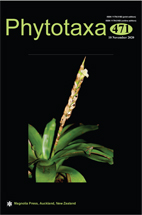Abstract
Pentzia arabica, previously known only from a few collections from Yemen, is reported also from Jabal Samhan in Oman. This is the first record of a Pentzia in Oman, and the locality is the northernmost and easternmost known for the genus. A map of the distribution of P. arabica and its presumed sister species, P. somalensis in Somalia, is presented. Apart from these two species in the Horn of Africa region, the disjunct Pentzia comprises 26 species in southern Africa and two species in North Africa.
References
IUCN (2012) IUCN Red List Categories and Criteria: Version 3.1 ed. 2. IUCN, Gland, Switzerland and Cambridge, UK.
Källersjö, M. (1988) A generic re-classification of Pentzia Thunb. (Compositae-Anthemideae) from southern Africa. Botanical Journal of the Linnean Society 96: 299–322.
<a href="https://doi.org/10.1111/j.1095-8339.1988.tb00686.x">https://doi.org/10.1111/j.1095-8339.1988.tb00686.x</a>
Magee, A.R., Nicolas, A.N., Tilney, P.M. & Plunkett, G.M. (2015) Phylogenetic relationships and generic realignments in the early diverging subtribe Pentziinae (Asteraceae, Anthemideae). Botanical Journal of the Linnean Society 178: 633–647.
<a href="https://doi.org/10.1111/boj.12295">https://doi.org/10.1111/boj.12295</a>
Magee, A.R. & Tilney, P.M. (2012) A taxonomic revision of Pentzia (Asteraceae, Anthemideae) I: the P. incana group in southern Africa, including the description of the new species P. oppositifolia Magee. South African Journal of Botany 79: 148–158.
<a href="https://doi.org/10.1016/j.sajb.2011.10.003">https://doi.org/10.1016/j.sajb.2011.10.003</a>
Mallon, D.P. (2011) Global hotspots in the Arabian Peninsula. Zoology in the Middle East 54, Suppl. 3: 13–20.
<a href="https://doi.org/10.1080/09397140.2011.10648896">https://doi.org/10.1080/09397140.2011.10648896</a>
Patzelt, A. (2014) Oman Plant Red Data Book. Diwan of Royal Court, Oman Botanic Garden, Sultanate of Oman, 312 pp.
Patzelt, A. (2015) Synopsis of the flora and vegetation of Oman, with special emphasis on patterns of plant endemism. Jahrbuch der Abhandlungen der Braunschweigischen Wissenschaftlichen Gesellschaft 2014: 282–317.
Thulin, M. (2001) Pentzia (Asteraceae-Anthemideae) in the Horn of Africa region. Nordic Journal of Botany 21: 249–252.
<a href="https://doi.org/10.1111/j.1756-1051.2001.tb00763.x">https://doi.org/10.1111/j.1756-1051.2001.tb00763.x</a>
Thulin, M. (2004) Horn of Africa. In: Mittermeier, R.A., Robles Gil, P., Hoffmann, M., Pilgrim, J., Brooks, T., Goettsch Mittermeier, C., Lamoreux, J. & da Fonseca, G.A.B. (Eds.) Hotspots revisited: earth?s richest and most endangered ecoregions. Cemex, Mexico City, pp. 276–283.
Thunberg, C.P. (1800) Prodromus plantarum capensium 2. Edman, Uppsala, 191 pp.
Källersjö, M. (1988) A generic re-classification of Pentzia Thunb. (Compositae-Anthemideae) from southern Africa. Botanical Journal of the Linnean Society 96: 299–322.
<a href="https://doi.org/10.1111/j.1095-8339.1988.tb00686.x">https://doi.org/10.1111/j.1095-8339.1988.tb00686.x</a>
Magee, A.R., Nicolas, A.N., Tilney, P.M. & Plunkett, G.M. (2015) Phylogenetic relationships and generic realignments in the early diverging subtribe Pentziinae (Asteraceae, Anthemideae). Botanical Journal of the Linnean Society 178: 633–647.
<a href="https://doi.org/10.1111/boj.12295">https://doi.org/10.1111/boj.12295</a>
Magee, A.R. & Tilney, P.M. (2012) A taxonomic revision of Pentzia (Asteraceae, Anthemideae) I: the P. incana group in southern Africa, including the description of the new species P. oppositifolia Magee. South African Journal of Botany 79: 148–158.
<a href="https://doi.org/10.1016/j.sajb.2011.10.003">https://doi.org/10.1016/j.sajb.2011.10.003</a>
Mallon, D.P. (2011) Global hotspots in the Arabian Peninsula. Zoology in the Middle East 54, Suppl. 3: 13–20.
<a href="https://doi.org/10.1080/09397140.2011.10648896">https://doi.org/10.1080/09397140.2011.10648896</a>
Patzelt, A. (2014) Oman Plant Red Data Book. Diwan of Royal Court, Oman Botanic Garden, Sultanate of Oman, 312 pp.
Patzelt, A. (2015) Synopsis of the flora and vegetation of Oman, with special emphasis on patterns of plant endemism. Jahrbuch der Abhandlungen der Braunschweigischen Wissenschaftlichen Gesellschaft 2014: 282–317.
Thulin, M. (2001) Pentzia (Asteraceae-Anthemideae) in the Horn of Africa region. Nordic Journal of Botany 21: 249–252.
<a href="https://doi.org/10.1111/j.1756-1051.2001.tb00763.x">https://doi.org/10.1111/j.1756-1051.2001.tb00763.x</a>
Thulin, M. (2004) Horn of Africa. In: Mittermeier, R.A., Robles Gil, P., Hoffmann, M., Pilgrim, J., Brooks, T., Goettsch Mittermeier, C., Lamoreux, J. & da Fonseca, G.A.B. (Eds.) Hotspots revisited: earth?s richest and most endangered ecoregions. Cemex, Mexico City, pp. 276–283.
Thunberg, C.P. (1800) Prodromus plantarum capensium 2. Edman, Uppsala, 191 pp.

